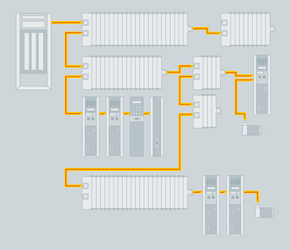Topology
- Slave devices can have several ports.
- Using these features, EtherCAT can support almost any physical topology (e.g., line, tree, or star).
- The bus or line structure known from the fieldbuses is then available for Ethernet.
The combination of line and branches or stubs is also possible.
- Any EtherCAT device with three or more ports can act as a junction; no additional switches are required.
- The classic switch-based Ethernet star topology can be used either with switches configured to forward traffic directly between ports, or with special slave devices.
- The switches are then located between the network master and the slave devices.
The special slave device assembly (i.e., standard slave devices don't have a MAC address) attached to one switch port together forms an EtherCATsegment. This is either addressed via its MAC address or via port-based VLANs.
- Since the 100BASE-TX Ethernet physical layer is used, the distance between any two nodes can be up to a maximum of 100 m (300 ft).
- Up to 65535 devices can be connected per segment.
- If an EtherCAT network is wired in ring configuration (requiring two ports on the master device), it can provide cable redundancy.
Figure 1: Flexible Topology: Line, Tree, or Star
- KAS controllers support line, tree, and star topologies.
- Ring topologies and cable redundancy is not supported because the KAS controllers have a singe EtherCAT port.







